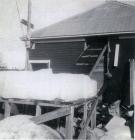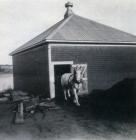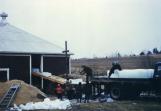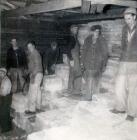7
This wooden platform was lined along the bottom with iron spikes which pressed into the ice making a non-slip surface for the crew to work on. After being cut, the ice blocks were angled to the base of the ramp using a long-handled hook with a spike. Two men then lifted the block to a raised platform where two more men hoisted it on to the truck. Two men were needed as the cakes of ice could weigh over 170 pounds.8
Loading ice into the icehouse20th century
The Tatamagouche Creamery, Creamery Road, Tatamagouche, Nova Scotia, Canada
 Credits:
Credits:North Shore Archives
Willis Cock
9
Once cut, the ice cakes were hauled to the the icehouse at the Creamery where it was stored for year round use. Ice could be picked up at the Creamery for home use, but most was used by Creamery. In the early days unloading ice to the icehouse meant shifting the heavy cakes to a wooden platform and then edging them on to a belt that carried the ice inside.10
Cleaning the icehouse at the Creamery20th century
The Tatamagouche Creamery, Creamery Road, Tatamagouche, Nova Scotia, Canada
 Credits:
Credits:North Shore Archives
11
After the ice had been used up, the remaining mess of wet saw-dust and hay which had helped to insulate the ice and keep it from melting had to be removed from the icehouse - a horse helped in this mucky process.12
Loading ice in icehouse became more efficient20th century
The Tatamagouche Creamery, Creamery Road, Tatamagouche, Nova Scotia, Canada
 Credits:
Credits:North Shore Archives
13
A more efficent process for moving ice from the truck to the icehouse was using an automatic conveyor belt. Eased from the truck, the ice went smoothly inside where it was efficiently stacked to fit as much ice as possible into the icehouse. Ice had to last a long time, so it was thickly covered with saw-dust and hay.14
Inside the ice house20th century
The Tatamagouche Creamery, Creamery Road, Tatamagouche, Nova Scotia, Canada
 Credits:
Credits:North Shore Archives
Willis Cock
15
As much ice was packed into the icehouse as possible because the supply had to last until the next winter. Summers were hot, so the ice was covered in several inches of sawdust to keep it insulated. Packing the ice closely together in the icehouse also helped keep it from melting.16
Hot water and steam were also essential to the Creamery. Steam from a boiler was used to heat and pasturize the cream as well as clean the cream cans and other equipment and utensils. It also served to heat the building with two hot water heaters with fans on the main floor and one on the second floor.Also, originally the equipment in the creamery was driven by a steam engine through a line shaft and various belts linked to the individual pieces of equipment. Later, the equipent was electrically driven.
17
Creamery boiler20th century
The Tatamagouche Creamery, Creamery Road, Tatamagouche, Nova Scotia, Canada
 Credits:
Credits:North Shore Archives
18
This large boiler was used to provide steam and hot water. It was manufactured in New Glasgow, Nova Scotia and was fired by coal mined in Nova Scotia that was delivered by rail to the Creamery, though it was later converted to oil.When this boiler was shut down to be cleaned or repaired a portable steam boiler was used during the interim. It was made at the New Glasgow Foundry in Pictou County, Nova Scotia, and currently is located at the Train Station Inn in Tatamagouche, close by the Creamery.
